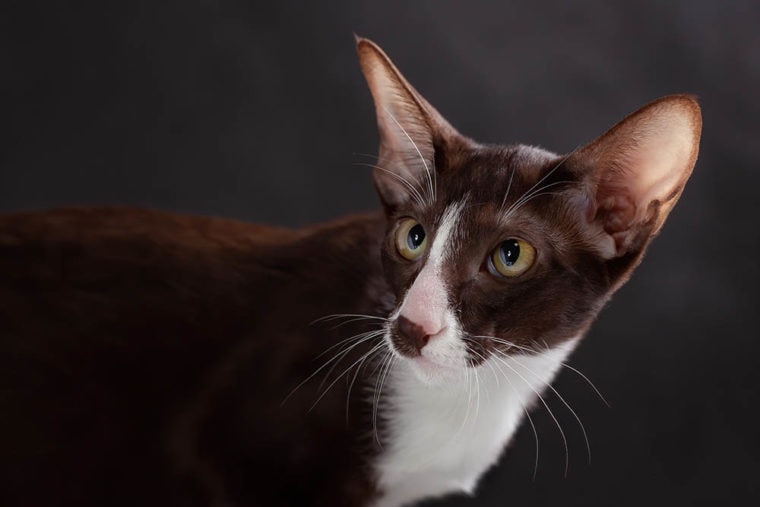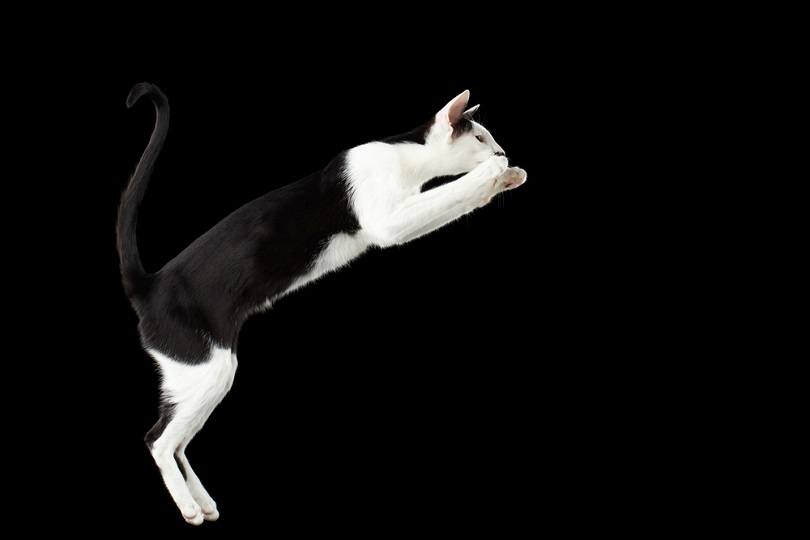
Click Below to Skip Ahead
If you’ve ever seen a purebred Siamese cat, you’ll understand why breeders fell in love with their long, lean bodies, angular faces, and oversized ears.
Breed Overview
Height:
9–11 inches
Weight:
8-12 pounds
Lifespan:
8–12 years
Colors:
Any solid or tabby with white
Suitable for:
Active families, multi-pet households, families with children
Temperament:
Adventurous, vocal, friendly, active
At first, these traits came hand-in-hand with the colorpoint coat patterns of a Siamese, but soon breeders crossed American Shorthairs, Siamese, and other cat breeds to expand the possible coloration, and the Oriental was born. Oriental Bicolors have white spots over a solid or tabby background, creating beautiful coat patterns in a rainbow of colors.
Oriental Bicolor Characteristics
Oriental Bicolor Kittens

If you want an Oriental Bicolor kitten, you’re in luck. Oriental cats are fairly common, and the bicolor type is one of the most common variants. Look for an oriental breeder with a good history of healthy litters and a relationship with a cat registry like TICA or the CFA. Many registries don’t distinguish between color types, so you will often see Oriental Bicolors registered and sold as Orientals, Oriental Shorthairs, or Oriental Longhairs.
Oriental Bicolors might occasionally come up in rescue groups for lower prices. After buying or adopting your Oriental Bicolor kitten, make sure that you have food, litter, toys, and treats ready so your kitty feels at home.
Temperament & Intelligence of the Oriental Bicolor
The Oriental Bicolor is a lively, active cat that needs a lot of care and attention. These cats are very clever and need a lot of stimulation to stay interested. They have a reputation for getting into trouble and being curious, so make sure that your house is extra cat-proofed, and you have the time to care for one of these cats before you adopt.
Are These Cats Good for Families? 👪
Oriental Bicolor cats often make good family pets because of their high energy and sociability. They thrive in households with family members at home for most of the day and get along well with adults, teenagers, and older children. These cats often are full of kittenish energy well into their adult years, so families with children who love playing with their cats might find them a good choice. Younger children should be supervised around pets—including cats. Once a child is old enough to play gently and recognize when a cat wants space, you can begin teaching good habits for unsupervised play.
In general, Oriental Bicolor cats may struggle in smaller apartments or in households where they are left alone for long periods of time. They love social interaction so spending time with other humans or pets is a must. They also like to have space to play. In smaller living quarters, vertical space in the form of cat trees and towers can help your cat have room to play without feeling cramped and maximize your space.

Does This Breed Get Along with Other Pets?
In general, Oriental Bicolors get along well with other pets. They are very social cats so they can be habituated to other dogs and cats. If your household is empty for most of the day, you might consider adopting two cats together or adding a second pet to the household to keep your cat company.
Like most cats, Oriental Bicolors enjoy hunting and shouldn’t be given access to small pets like birds, fish, and small mammals. Many Oriental Bicolors will attack small pets when given a chance. Although training can have an impact on behavior, in general it is safest to make sure your small pet enclosures are cat-proof and supervise any interactions.
Things to Know When Owning an Oriental Bicolor
Food & Diet Requirements 🐡
Oriental shorthair cats are very active, so high-quality, high-protein food is a must. However, many cats struggle with overeating, so it’s important to monitor your cat’s weight and portion food as necessary. In general, adult Oriental Bicolor cats need about ⅓ to ½ cup of dry food each day or 4–5 ounces of wet food. However, you should follow your cat food manufacturer’s guidelines and adjust as necessary to keep your cat at a healthy weight.

Exercise 🐈
Oriental Bicolor cats are very active and need a variety of types of exercise. Many oriental cats are known for their ability to easily jump onto high shelves or ledges, often jumping six feet or higher. Oriental Bicolor cats require scratching posts and a variety of types of toys to exercise, and some daily interaction time is a must for healthy development.
Training 🧶
Oriental Bicolor cats are very intelligent and social, but their curiosity and stubbornness can get in the way of training. Repeated positive reinforcement and redirection of negative behaviors is important. If your Oriental Bicolor is acting out frequently, it’s likely that he doesn’t receive enough stimulation or is feeling ignored.

Grooming ✂️
Grooming needs vary depending on your Oriental Bicolor’s coat. Oriental Shorthairs are usually easy to care for, needing only occasional brushing to minimize shed fur and otherwise able to care for themselves. Long-haired cats may need regular brushing one or two times a week to avoid mats and snarls. As cats grow older, their ability to clean themselves may diminish, and more brushing and bathing might be required.
If you decide to trim your cat’s claws, make sure that you trim them regularly every 3-6 weeks. You should never cut too close to the base of the claw as cats have blood vessels inside the lower portion of the claw. Instead, focus on blunting the tip of the claw so that they can do less damage when scratching.
Health and Conditions 🏥
Oriental Cats are generally a healthy breed except for two serious health conditions that are common in the breed. Oriental Bicolors may suffer from an eye disease called Progressive Retinal Atrophy that causes vision loss over time. They might also suffer from a disease called Hepatic Amyloidosis. This rare disease involves deposits building up in your cat’s liver, leading to liver failure. Both diseases have genetic components that can lead to an increased chance of the disease, so look for a breeder without a history of either condition. In addition, regular vet checkups are important to keep an eye out for these or any other conditions so they can be treated quickly.
Male vs Female
The differences between male and female Oriental Bicolors are slight, but they do exist. Males tend to be larger and have more energy. Neutered males tend to be the most stable type of cat and do well in multi-cat households. When unaltered, male cats often spray and become aggressive and territorial toward other cats.
Female cats have a slightly higher incidence of separation anxiety. Spaying your female cat will extend her lifespan and improve her health and stability. Female cats can also adjust to multi-pet households, but many owners report a higher level of difficulty in adjusting to new pets as compared to male cats.
3 Little-Known Facts About the Oriental Bicolor
1. Oriental Bicolors can be long-haired or short-haired
Siamese cats are generally shorthaired, so many Oriental Bicolors have short fur as well. But there are also beautiful long-haired variations that have an elegant, refined look and delightfully soft coats.
2. Oriental Bicolors are hypoallergenic
No cat is 100% guaranteed to be allergy-free, but Oriental cat variants have a lower rate of shedding and produce less dander than most other cats, especially the shorthair type. If you have mild cat allergies, an Oriental Bicolor might be a great choice.
3. Oriental Bicolors are recognized by the GCCF
Most cat fancy associations group all Oriental cats except Siamese together into one breed, but some specify a color type. The Governing Council of the Cat Fancy, one of the largest breed registries, recognizes several color variations including the Oriental Bicolor in their breed registries.
Final Thoughts
The Oriental Bicolor is a beautiful newer cat breed instantly recognizable for its white-spotted coat and sleek, exotic body type. These cats aren’t ideal for busy owners, but if you have the time to devote to caring for this cat breed, you’ll be richly rewarded. Intelligent, curious, and social, these cats are some of the most extroverted and energetic cats you could find, making them a great choice for active families or those with the time to care for them.
See Also:
Featured Image Credit: Irina Nedikova, Shutterstock






